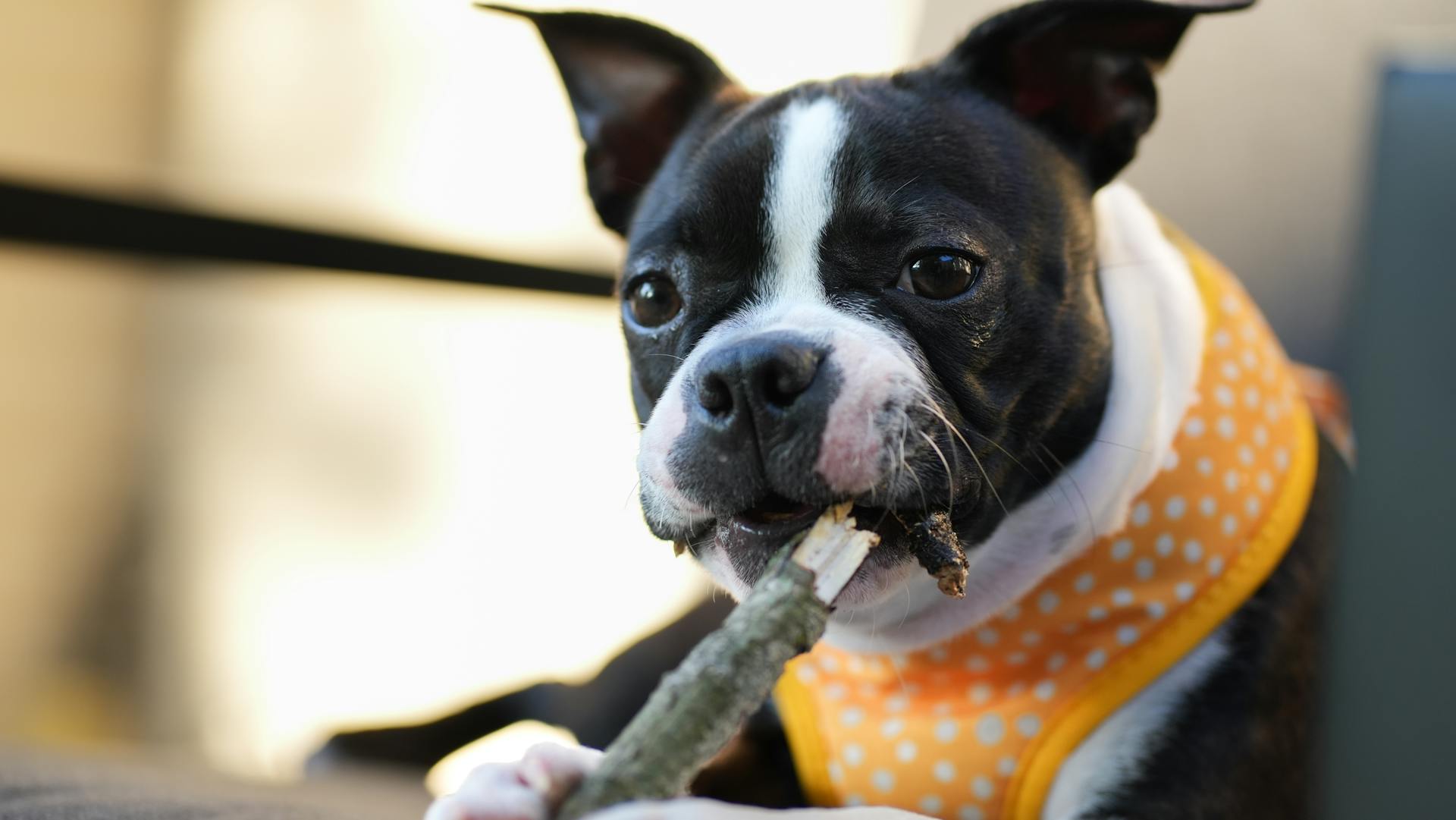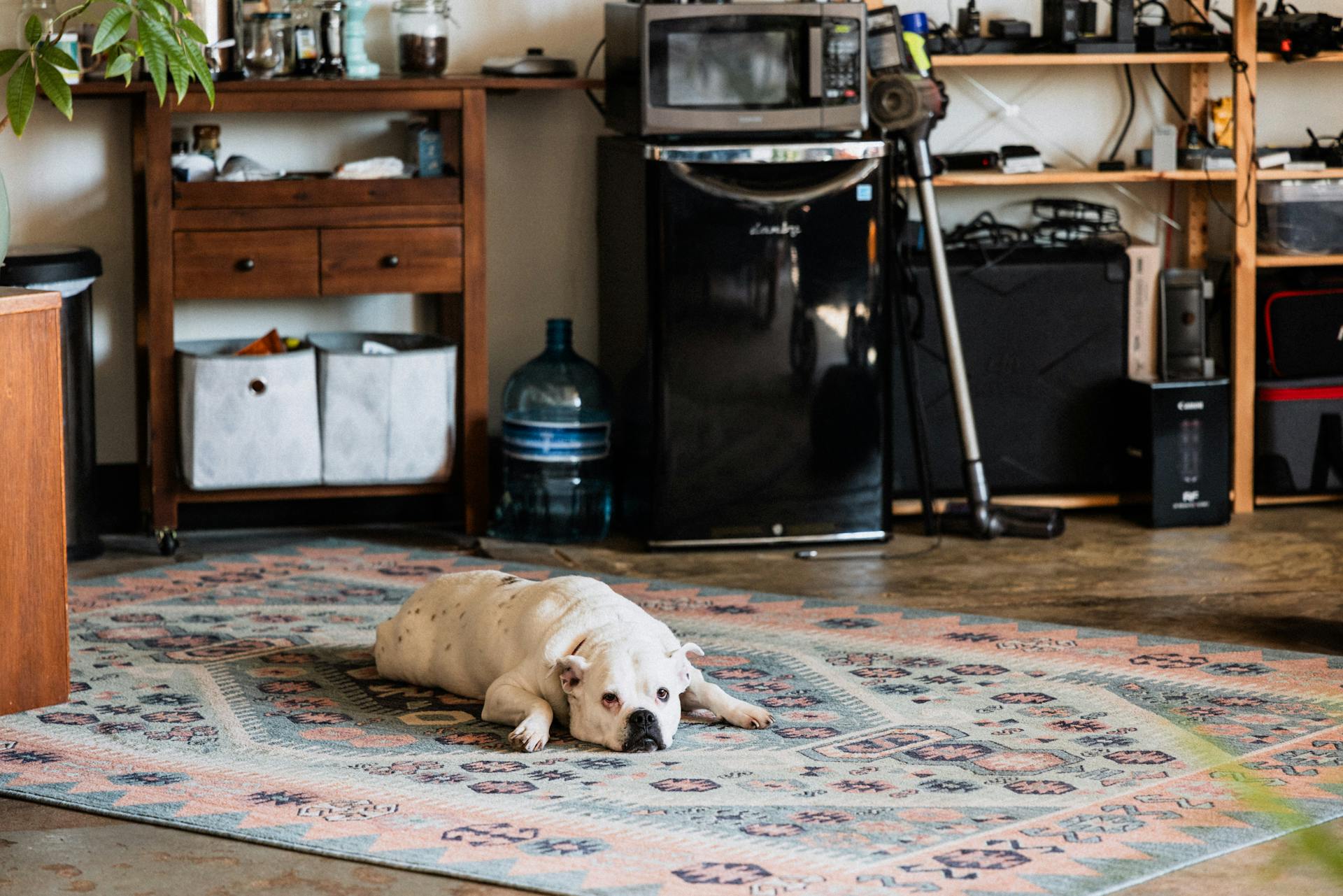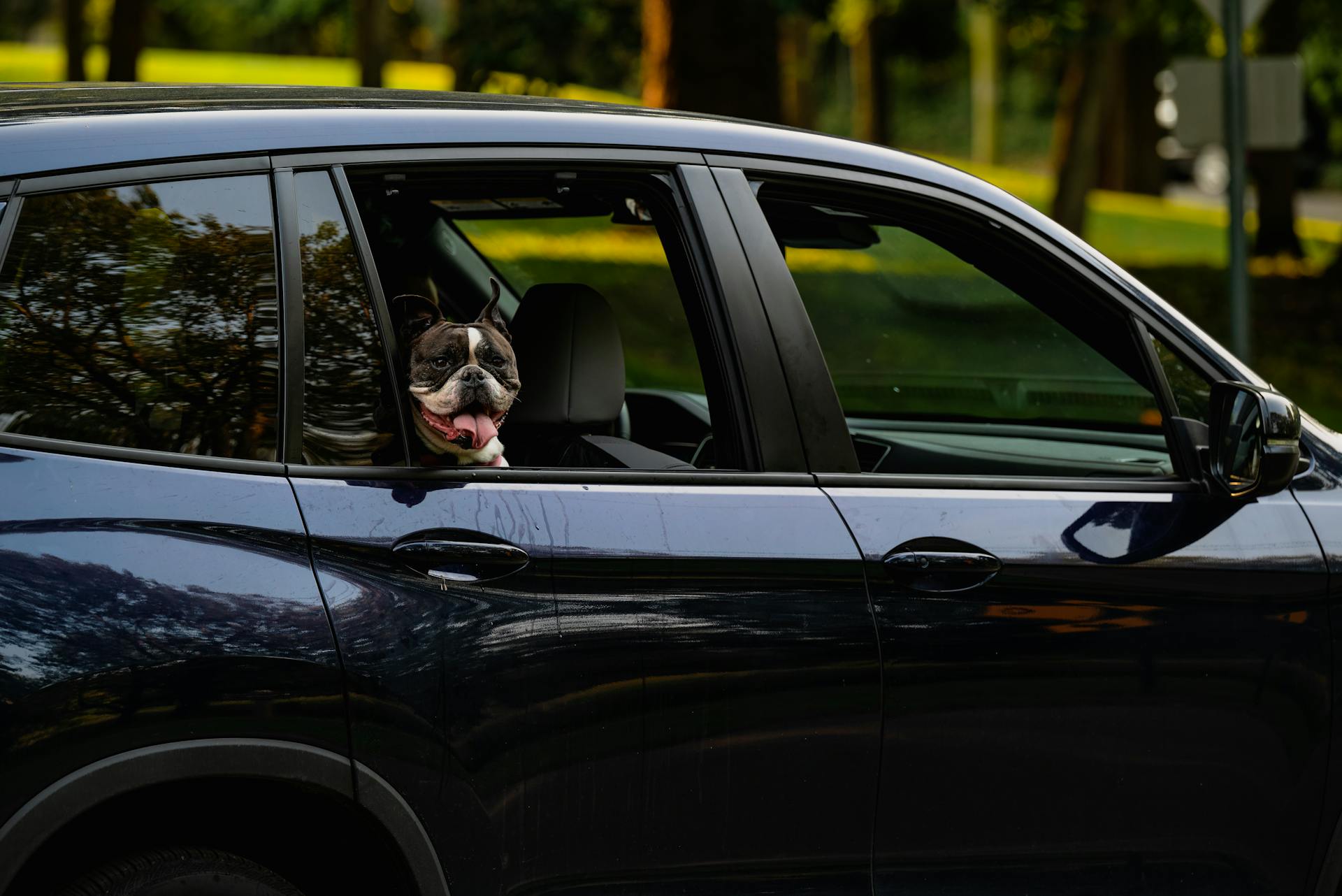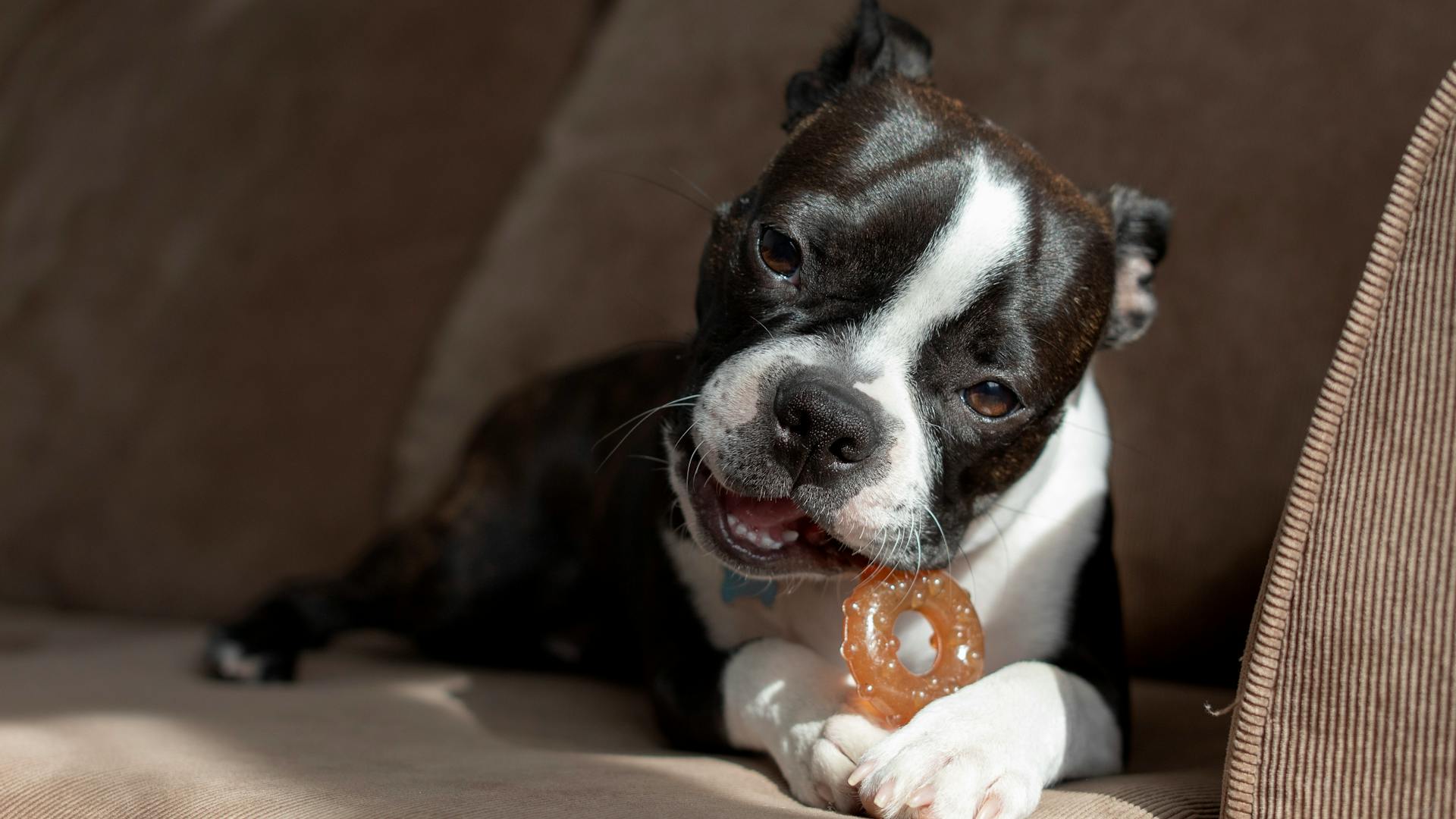
Boston Terriers and cats can get along famously, but it's essential to set them up for success from the start. Boston Terriers are naturally friendly dogs that can adapt to living with cats if socialized properly.
To ensure a peaceful coexistence, it's crucial to introduce the Boston Terrier and cat slowly and under controlled circumstances. This can be done by keeping them separated at first and allowing them to become familiar with each other's scents and sounds.
By doing so, you can help prevent any initial aggression or fear-based behaviors that might arise when they're finally introduced.
See what others are reading: Boston Terrier Reverse Sneezing
Building a Relationship
Boston Terriers and cats can develop a harmonious relationship with time, patience, and proper introductions.
Boston Terriers are great with cats and other animals, thanks to their kind and loving temperament.
Introducing your Boston to a cat should be done slowly, just like introducing them to another person or dog.
A careful introduction between the two animals will help them build trust in each other, which can lead to fewer instances of chasing.
If you raise your dog and cat together from a young age, you have a much higher chance of them getting along.
However, it's not impossible to introduce a Boston Terrier and a cat later in life - just be patient and move slowly.
The key to introducing a dog and cat is patience, and moving slowly and in increments.
Boston Terrier owners surveyed reported that the majority of their dogs are good with cats.
Consider reading: Boston Terrier at Dog Show
Terrier and Cat Interactions
Boston Terriers and cats can make great companions if introduced properly. It's essential to start with a friendly cat to encourage a positive association between both animals.
Boston Terriers have a natural prey drive, which can vary from dog to dog. This instinct can be influenced by factors such as socialization, training, and individual temperament.
Supervise initial interactions between your Boston Terrier and cat, keeping them short and just a few minutes long. This will help prevent any potential conflicts and allow both animals to get used to each other's presence.
Natural Instincts
Boston Terriers have a natural prey drive, which can vary from dog to dog and is influenced by factors such as socialization, training, and individual temperament.
Some Boston Terriers may have a high prey drive and be more inclined to chase or exhibit predatory behavior towards cats.
A dog's prey drive can be shaped by their socialization and training, but it's also influenced by their individual temperament.
Boston Terriers with a high prey drive may be more energetic and restless, especially if they're not getting enough exercise or mental stimulation.
Their natural instincts can also be triggered by the presence of small animals, including cats, even if they've been socialized to live with them.
Some Boston Terriers may be more tolerant and accepting of feline companions, but it's essential to remember that their natural instincts are still present.
Boston Terriers with a high prey drive may require more attention and exercise to keep them calm and focused around cats.
Broaden your view: Boston Terrier Temperment
Animals Eat Near Each Other

Having both your Boston Terrier and cat eat near each other is a great way to test their comfort level with each other's presence. This is a good sign that they feel safe and unthreatened.
Start by setting up their feeding stations a safe distance away from the gate, and then gradually slide their food bowls closer to each other based on the comfort level of each animal. You may need to start far away and work your way up.
Keep in mind that every dog and cat is different, and some may take longer than others to feel comfortable eating near each other. So, be patient and don't rush the process.
As your Boston Terrier and cat become more comfortable with each other, you can close the gap between them by keeping them in the same room. Keep your Boston Terrier leashed and let your cat roam around the room.
Worth a look: Boston Terrier Shedding Level
Safety Precautions
Safety Precautions are crucial when introducing a Boston Terrier to a cat. Keep your cat's claws trimmed to minimize the risk of injury if they swat or scratch during interactions.
To provide a safe environment, set up escape routes and hiding spots for your cat, such as cat trees, shelves, or high perches that are inaccessible to the dog. Use baby gates or pet barriers to create physical separation between the Boston Terrier and cat initially.
Supervise interactions between your Boston Terrier and cat, especially during the initial introduction phase, to intervene if necessary and prevent any potential conflicts or injuries. Reward calm behavior with treats and praise to encourage peaceful coexistence.
By following these precautions and being patient, you can help ensure a safe and positive interaction between your Boston Terrier and cat.
Separate Pets by Room
Keeping your Boston Terrier and cat in separate rooms for a few days is a great way to start the introduction process. This allows them to get used to each other's presence without feeling overwhelmed or threatened.
It's essential to keep an eye on their behavior and look for any signs of discomfort or fear. If you notice either pet acting strangely, it's best to give them more time to adjust.
By separating them by room, you're also giving your cat a safe space to retreat to if needed. This can include a high perch or a cozy hiding spot where they can feel secure.
Remember to keep an eye on your cat's claws during this time, as they may become more agitated and swat or scratch if they feel threatened. Trimming your cat's claws can help minimize this risk, but be sure to consult with your veterinarian or a professional groomer for guidance.
Here's a simple checklist to help you keep track of your pets' behavior:
By following these steps, you'll be well on your way to a smooth and safe introduction between your Boston Terrier and cat.
Keep Leashed
As you work on introducing your Boston Terrier and cat, it's essential to keep your dog leashed, especially during the initial stages. This will help prevent any sudden movements that might scare your cat.
Keep your Boston Terrier on a leash for the first same-room introductions, as well as when letting them feed on opposite sides of a baby gate or a glass door. This will help maintain a safe distance and prevent any potential conflicts.
To ensure a smooth introduction, it's crucial to keep your dog leashed during these initial meetings, even if they seem calm. You can always unhook the leash once they've shown calm body language.
Gradually loosen your hold on your dog as they become more comfortable with the presence of your cat. Be prepared to intervene if either animal starts to show signs of discomfort.
Recommended read: How Big Will My Boston Terrier Get
Final Thoughts
Boston terriers are indeed loving animals, and with patience and proper introduction, they can get along great with cats.
It's essential to exercise your Boston before the official introduction to ensure they're not too energetic for the cat.
Give the two pets time to meet on their own terms, allowing them to get to know each other slowly and naturally.
Sources
- https://bostonterrier.world/blogs/boston-terrier-world-blog/do-boston-terriers-get-along-with-cats
- https://www.hepper.com/are-boston-terriers-good-with-cats/
- https://www.bostonterriersociety.com/boston-terriers-and-cats/
- https://www.dogster.com/dog-breeds/will-a-boston-terrier-be-good-with-a-cat
- https://www.dailypaws.com/pet-news-entertainment/unlikely-friendships/boston-terrier-bengal-cat-ride-scooter-guinness-world-record
Featured Images: pexels.com


